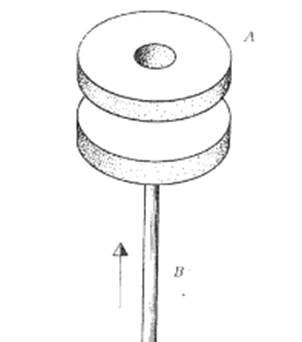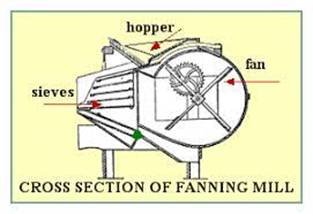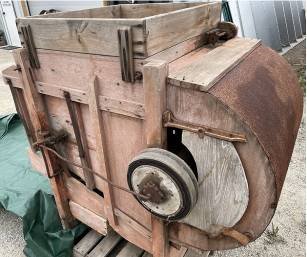Title: | Clover Engine at Michaelchurch Mill |
Date: | 1815 |
Clover Engine at Michaelchurch Mill
By Bob Steele
The sale particulars for the Michaelchurch Estate in 1815 boast of "a very excellent Water Corn Grist Mill and Clover Engine, in full business" at Michaelchurch Escley. Clover was not widely grown in Ewyas Lacy - in 1835 less than 4% of the arable land on the Michaelchurch Estate was planted with it. But assuming this was not merely an invention of the auctioneers’ hyperbole to make the Estate more attractive to potential buyers - like the supposedly abundant deposits of copper and lead ore in the Manor of Ewyas Lacy that were enthusiastically but erroneously claimed in 1863 sale particulars - the question arises as to why Michaelchurch Mill might have possessed a ‘clover engine’ and what exactly it was.
Towards the end of the eighteenth century the practice of sowing upland fields in hay, usually timothy grass and, most importantly, red clover became widespread as part of a 'revolution' in agricultural practices to improve crop yields and support more intensive animal husbandry. Clover is not a grass, but a legume. Certain bacteria which grow symbiotically on its roots absorb nitrogen from the atmosphere and transform it into ammonium compounds which aid the plant’s growth in a process known as nitrogen fixation. When the roots and stubble are ploughed under, the decaying plants then release the fixed nitrogen into the soil. Red clover thus earned the nickname “green manure” and before the development of commercial fertilizers it was used in a rotation system to prepare fields for later crops of wheat, corn or other grains. At the end of a season the clover was harvested and separated to produce the seed for the next crop and clover hay for animal feed, which is nutrient rich and high in protein. Thus, sown to clover, a field’s fertility was not only restored more effectively than letting it lie fallow but it also provided winter fodder for livestock.
A hindrance to the new clover-based crop rotation system was the poor quality and availability of seed and the fact, not realized initially, that clover needs a slightly alkaline soil. When the soil issue was understood the production of clover was greatly enhanced by the practice of spreading lime or gypsum, called “land plaster,” on fields. Both of these added much needed calcium and most importantly they are strongly alkaline, neutralizing soil acidity. To be applied to fields as a soil conditioner and plant nutrient, crushed limestone had to be fired to a red heat for several days in a limekiln. The roasting process broke the limestone down to a highly alkaline, chemically active powder that was thinly spread on fields.
Agricultural lime was applied at the rate of about fifteen to twenty bushels per acre. It required about fifteen cords of wood to fire a kiln yielding 1000 bushels of lime. Investment on this sort of scale was beyond the reach of individual local farmers hereabouts, but there are numerous references in historical documents to the operation of lime kilns by the larger Ewyas Lacy estates in places where there are limestone outcrops in the Manor.
As clover acreage and yields increased, seed became available in greater quantities but collecting it was a difficult task. Red clover blossoms shrivel and dry to a leathery pod which contains the tiny seeds and extracting the seeds from the tough pod was far from easy. In the days before mechanization, clover seed was collected in the same manner as cereal grains, requiring strenuous manual labour. The clover plants were first cut and dried. Then they were spread on the barn floor on sheets and manually beaten with flails to break up the pods and release the seeds. When the large plant material was removed, the seeds remained on the sheets, along with dust and small bits of broken stems, leaves and blossoms known as chaff.
The chaff was removed through a process called winnowing. When there was a breezy day, the seed and chaff were placed on a winnowing tray and then tossed in the air repeatedly. The breeze carried away the lighter weight chaff while the cleaned seed fell back onto the tray. Barns were traditionally built with large doors set opposite each other, and oriented so as to funnel the prevailing winds through them across the winnowing floor, blowing the chaff out the other side. This was not an efficient process and undoubtedly much seed was lost using these manual methods.
In the early part of the nineteenth century clover mills were developed to collect and clean the seed in a more efficient manner. Enterprising mill owners adapted water powered grist mills using millstones to shred the leathery clover pods without crushing the seeds. The earliest mills utilized rough cut millstones that crushed the flower heads between them as they rotated. Clover mills, as they were known, used “bottom runner” stones. The top stone was stationary and the bottom one turned, the opposite arrangement to the traditional corn and grist mills, so these clover mills were set up separately as stand-alone machines and were probably driven from their own lay shaft or belt as with other ancillary mill machinery to harness the power from the waterwheel. The stones typically would be smaller than the traditional corn or grist millstones and the top stone had a much larger opening - up to a foot wide - through which the clover seed pods were introduced.
|
|
| Top and Bottom millstones as in a clover mill |
The millstones were carefully levelled and placed just far enough apart to crack open the seed pods without damaging the seed, which was expelled out of the sides where it was collected with the aid of a wooden tun arrangement surrounding the stones akin to that used for grist milling. Some clover mills appear to have used wooden spars reinforced with metal plates in place of a fixed top stone, which may have been a cheaper alternative more easily manufactured by local craftsmen as in the illustration below.
|
|
| Diagram of a clover mill with a single bottom runner stone Drawing by John Brandrick; http://www.milldrawings.com/ |
A winnowing machine or 'fanning mill' - a piece of equipment often present in watermills for cleaning grain before milling and which could be belt driven from a lay shaft in the mill - would then be used to clean the seeds of chaff and debris from the pods, using a series of sieves of decreasing sizes that were mechanically shaken to screen out the larger material. Rotating fan blades created a breeze to blow away the lightweight chaff and dust. These winnowing machines reputedly met with much prejudice when first introduced, especially amongst the clergy, who labelled them the “Devil’s Wind” claiming that the machines “impiously thwarted the will of Divine Providence by raising wind by human art instead of soliciting it through prayer.”
|
|
|
| Winnowing machine or ‘fanning mill’ | |
In the early 1800s innovation in agricultural machinery was rapid and newer threshing machines were soon devised which could perform the same tasks more efficiently. They had a cylinder with sharpened serrated bars attached which rotated at a high speed within a concave enclosure shaped to follow the curvature of the cylinder. The plant material was fed through a hopper into the enclosure where it was broken up by the rotating bars. The grain and chaff then dropped down through a series of shaking sieves while the remainder of the plant material exited through a chute. A fanning mill was usually used in conjunction with the threshing machine to separate the grain from the chaff. Later threshing machines combined these two functions into one machine with the addition of fan blades to blow away the chaff. The machines designed to harvest and clean clover seed also included a rasp-like device that rubbed off the hulls to release the seeds, and became known as 'clover engines', although the term may also have been used for the earlier millstone based clover mills.
But what of the clover engine at Michaelchurch Mill? There is no record of whether it was the early type with millstones or a more sophisticated later machine perhaps belt driven from the lay shaft that engaged with the crown wheel. Either way, it seems that it was not a great success; by 1863 when the Estate was next advertised for sale there is no mention of it in the mill particulars. Its demise may have been due simply to lack of demand with relatively few acres of clover being grown locally, or perhaps it was overtaken by competition from the rapid rise of threshing contractors using steam traction engines as the technology of the industrial revolution spread. These new players in the market could take their machinery directly to the local farms and provide the power to run it there without all the cost, labour and inconvenience of farmers transporting their crops to the watermill. Much of the rest of the miller's traditional business was destined gradually to go the same way as the importance of waterpower in the rural economy continued to decline.
Ref: rs_ewy_0358




